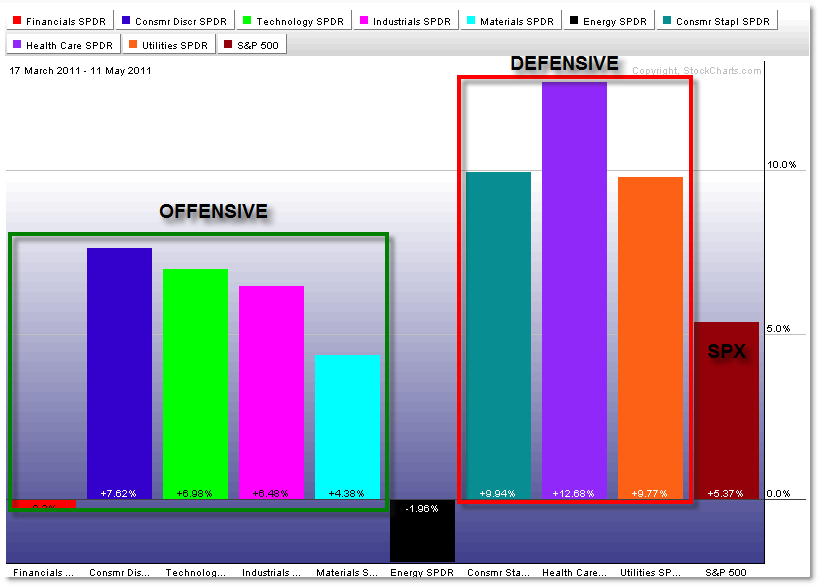Clear Bearish Signals Developing from Sector Rotation Model
What does the Sector Rotation Model reveal about the current market situation?
Money appears to be flowing into Defensive Sectors and in part away from Offensive Sectors, which is a clear “Caution” or warning sign for the market at the moment.
Let’s take a look at Sector Performance Year-to-Date:

I break down the nine Sector SPDRs into Offensive and Defensive categories as shown above (with Energy as its own category).
The Year-to-Date ETF returns show the relative out-performance in the DEFENSIVE sectors of Consumer Staples (up 9%), Health Care (up 13%), and Utilities (up 8.5%).
These three “bearish” or defensive sectors have eclipsed the S&P 500’s return year to date of 5%.
The only other sector that comes close is the Industrials (XLI) which are up 8.5% followed by Consumer Discretionary, up 7%.
Offensive/Bullish components Financials, Technology, and Materials are all under-performing not only the other sectors, but the S&P 500 itself.
As long as these trends continue (money/performance flowing to the Defensive Sectors and away from the Offensive Sectors), the broader market flashes an objective “Caution” sign.
The above chart suggests that bigger funds are positioning themselves Defensively, which implies they see future trouble ahead for the broader stock market.
While the chart above starts the comparison at the beginning of January to present, let’s take another look starting the comparison at the March 15th low to capture Sector Performance during the recent very bullish price rally.
Sector Performance after March 15th’s low to Present:

I have to admit, I’m surprised by what I’m seeing in the chart above.
Though the S&P 500 is up over 5% from its 1,250 low, the three Defensive Block Sectors are all up double what the S&P 500 returned – Staples up 10%; Health Care up 12% and Utilities up 10%.
During the bullish – virtually straight-up rally (until present), strength also came from the Offensive Sectors as shown, but not as strong as the performance in the Defensive Three.
The XLF Financials ETF declined slightly during this period (as did Energy – down 2%). Energy got caught in the “Commodity Crash” in May, while the broader stock market held its own (relatively speaking).
Even during the recent rally phase, money flowed into Defensive Sectors, and in terms of Energy and Financials, away from some offensive sectors.
As long as this pattern continues, it does not bode well for the broader stock market, at least in terms of the Sector Rotation Model.
Continue watching these sectors for any new developments.
Corey Rosenbloom, CMT
Afraid to Trade.com
Follow Corey on Twitter: http://twitter.com/afraidtotrade
Corey’s new book The Complete Trading Course (Wiley Finance) is now available!

Look I'm bearish too, but this is a slender reed.
1) Can you see that it is empirically proven that a rotation into defensive sectors precedes a top? Show me the research.(You also said the same rotation took place during the rally phase).
2) Are you saying that the big funds are prescient? Are they suddenly, magically, smart money?
Feels like sloppy thinking.
j'adoube
Correction:
Can you say . . .
Sector Rotation analysis is a piece of the puzzle just as trend analysis, sentiment analysis, intermarket analysis, Elliott Wave analysis, fundamental/economic analysis, and so on.
It has objective criteria which I'm using – discussed in Sam Stovall's work along with Peter Navarro, Martin Pring, John Murphy and others which I strongly suggest reading – but there's no form of analysis that's 100% – the 'weight of the evidence' model works best, not taking large-scale positions on one form of analysis.
Do you like the rising wedge pattern in major stock indexes? I say we get one more pop to the upper trend line, then the sound of millions of cash registers worldwide going off.
very simple and straight to the point, I like it. cheers
I have a question on reading the chart above. Do we always use Year to Date as the starting point?
Can you list what the ETF's are for these charts? I know XLF for Financials. Thanks.
Lewis,
No, when using the model, it's best to take the start from a key inflection point in the market – either a major swing high or a major swing low to present.
The year to date is just a reference point. The signal is similar when starting with the March 15 inflection low, however.
Sure, StockCharts pulls in the data from the 9 major Sector SPDRs as the following:
http://www.sectorspdr.com/
XLF – Financial
XLI – Industrial
XLY – Discretionary
XLB – Materials
XLK – Technology
XLE – Energy
XLV – Health Care
XLP – Staples
XLU – Utilities
Hi Corey – what other indicators could i look at to determine if this might be becoming a sustainable rotation? And in looking at the charts of those three – they look kinda extended – so what should i look for in a retracement entry and finally – is there any past history that i can look at that might give me an idea on how far or long this rotation might last?
perhaps sector rotation reflects something moe than big fund manager thinking?